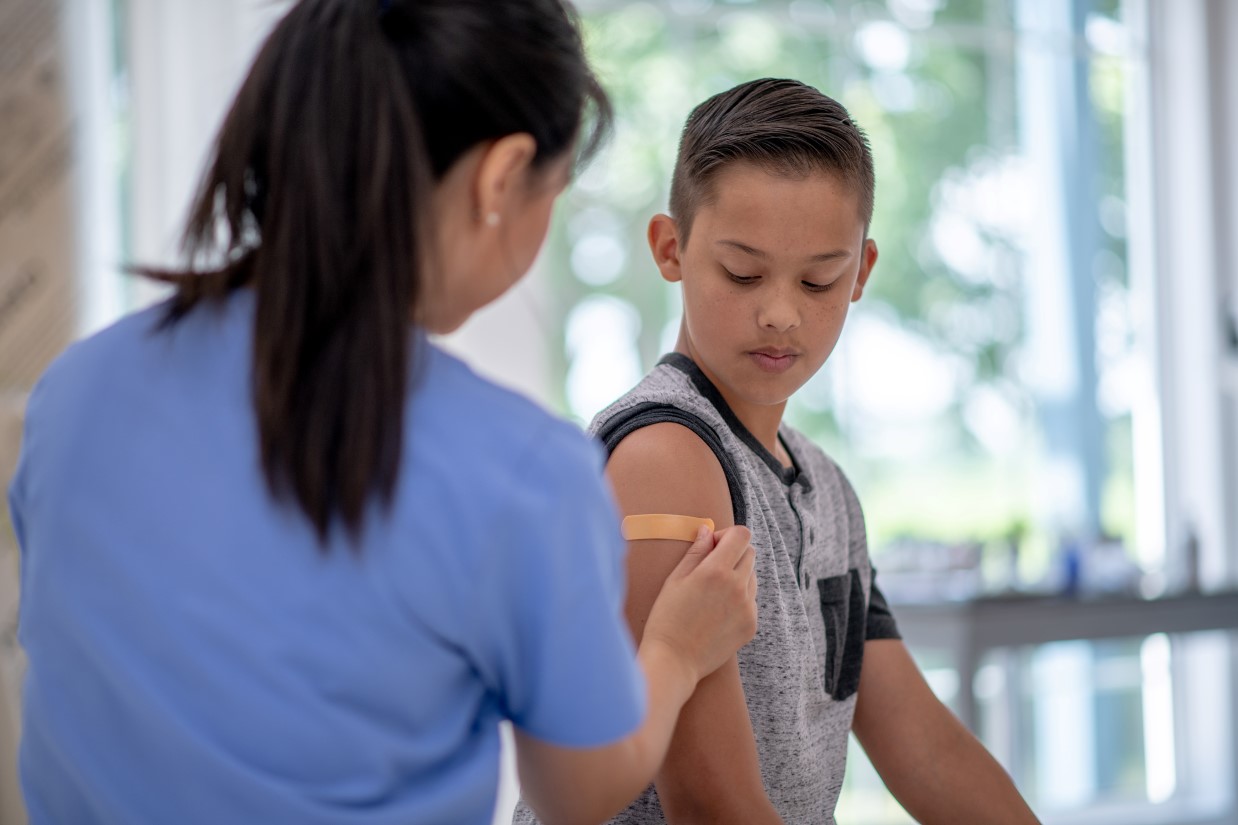Healthnet.com uses cookies. By continuing to use our site, you agree to our Privacy Policy and Terms of Use.
You Can Live Longer When You Screen for Cancer
Learn How Cancer Screenings Can Help Prolong Your Life

What Cancer Is And Why You Should Know1
Cancer is not simply one disease. Cancer comes in many forms that share a similar trait: rampant cell growth and division.
Cancers, as a group, are very common. They’re the second leading cause of death in the United States, second only to heart disease and fatal issues within the blood vessel system.2
Screenings: How to Prevent Cancer or Find It Early
Screening means checking your body for cancer before you have symptoms. Screening tests may find cancers early when treatment is likely to work best.
How you can lower your risk of getting cancer
You can help lower your risk of getting many common kinds of cancer by making healthy choices. Vaccines (shots) can help prevent many kinds of cancer as well.

The American Cancer Society states that one of every two men and one of every three women will have some form of cancer at some time in their lives.3
Screening tests

CDC supports screening for breast, cervical, colorectal and lung cancers as advised by the USPSTF.
When you get routine screening tests, results may show breast, cervical or colorectal (colon) cancer is present. Catching cancer early is ideal. That’s when proven treatment is likely to work best. Routine lung cancer screening is also advised for some people who are at high risk.
Breast cancer – Mammograms are the best way to find breast cancer early when it’s better to treat. And before the cancer is big enough to feel or to cause symptoms.
Cervical cancer – The Pap test can find deformed cells in the cervix which may become cancer. The test can also find cancer early, when the chance of being cured is very high.1 The human papillomavirus (HPV) test looks for the HPV virus. The HPV virus is a common disease transferred when you have sex. HPV can cause cell changes which may become cancer as well.
Colorectal cancer – Colorectal cancer almost always evolves from polyps (tissue growths) in the colon or rectum. Screening tests can find these polyps, so they can be removed before they become cancer. The tests also can find cancer early which allows treatment to work at its best. Less invasive tests include a a FIT test and a FIT-DNA test or Cologuard® test. Speak to your doctor to learn more about the best screening test for you.
Lung cancer – The U.S Preventive Services Task Force (USPSTF) suggests yearly lung cancer screening for people who are heavy smokers – both past and present. And for people who have quit within the past 15 years, and are between 50 and 80 years old.
Screening for other kinds of cancer
Screening for other types of cancer has not been proven to reduce deaths from those cancers, which include:
- Ovarian
- Pancreatic
- Prostate
- Testicular
- Thyroid
Vaccines (shots)
Vaccines (shots) can also help lower your cancer risk. The HPV vaccine helps prevent most cancers of the cervix and many other kinds of cancer. The Hepatitis B vaccine can also help to lower your liver cancer risk.
Some cancers are caused by HPV. The HPV vaccine protects against the types of HPV that most often cause these cancers.
- HPV vaccine is advised for preteens aged 11 to 12 years. It can be given starting at age 9.
- HPV vaccine also is advised for everyone through age 26 if they have not received a vaccine yet.
- HPV vaccine is not advised for everyone older than age 26. But some adults age 27 through 45 years who have not been vaccinated may decide to get the HPV vaccine. They should do this after speaking with their doctor about their risk for HPV. And about the benefits of vaccination.
Note: An HPV vaccination for people aged 27-45 provides less benefit, as more people have likely been exposed to HPV.
An HPV vaccination prevents new HPV infections. But it does not treat current infections or diseases. This is why the HPV vaccine works best when given before you are exposed to HPV.

![]()
The HPV vaccine does not replace the need for routine cervical cancer screening tests (Pap and HPV tests), based on advised screening guidelines.

Healthy choices
You can lower your risk of getting cancer by making healthy choices – like when you:
- Avoid tobacco
- Protect your skin
- Limit the amount of alcohol you drink
- Keep a healthy weight
- Get tested for Hepatitis C
Avoid tobacco
Cigarette smoking – Lung cancer is the leading cause of cancer death. And cigarette smoking is the number one risk factor for lung cancer. In the United States, cigarette smoking is linked to about 80 to 90 percent of lung cancer deaths. Tobacco use can cause cancer in almost any part of your body. Visit smokefree.gov to learn how you can quit smoking.
Secondhand smoke – Smoke from other people’s cigarettes, pipes or cigars is termed secondhand smoke. It can also cause lung cancer. When a person breathes in secondhand smoke, it’s just as if they are smoking.
Protect your skin
Skin cancer is the most common kind of cancer in the United States4 . When you expose your skin to ultraviolet (UV) rays from the sun or tanning beds you become a greater risk for getting skin cancer. To help prevent skin cancer while still having fun outdoors, you can protect yourself when you:
- Stay in the shade
- Use plenty of sunscreen
- Wear clothes that protect you from the sun(e.g. a hat and long-sleeved shirt)
Limit alcohol intake
When you drink alcohol it raises your risk of getting six kinds of cancer1. The less alcohol you drink, the lower your risk for cancer.
Keep a healthy weight
Having excess weight or being obese is linked to a higher risk of getting 13 types of cancer1. These cancers make up 40 percent of all cancers diagnosed in the United States each year.
Get a Hepatitis C test
Hepatitis is swelling of the liver, which is most often caused by a virus. In the United States, the most common type of viral hepatitis is Hepatitis C. Over time, chronic Hepatitis C can lead to harmful liver problems which include:
- Liver damage
- Cirrhosis
- Liver failure
- Liver cancer
The Centers for Disease Control and Prevention (CDC) suggests that most adults get tested for Hepatitis C (PDF).

Breast Cancer Statistics5
![]()

Breast cancer accounts for 12.5 percent of all new yearly cancer cases worldwide. This makes it the most common cancer in the world.
Breast cancer is the most often found cancer among U.S. women. Each year, about 30 percent of all newly found cancers in women are breast cancer.
Roughly 13 percent (about one in eight) of U.S. women are going to develop invasive breast cancer (cancer that has grown into the breast tissue) in the course of their lives.
There are now more than four million women with a history of breast cancer in the United States. This includes women who are being treated now and women who have finished treatment.
In the United States, less than 1 percent of all breast cancers occur in men.
Colorectal Cancer Statistics6
Colorectal cancer is the third most common cancer found in both men and women in the United States (excluding skin cancers). The American Cancer Society’s 2024 forecast for the number of colon cancers in the United States are:
- About 106,590 new cases of colon cancer (54,210 in men and 52,380 in women)
- About 46,220 new cases of rectal cancer (27,330 in men and 18,890 in women)
The rate of people found having colon or rectal cancer each year has dropped overall since the mid-1980s. This is mainly due to more people getting screened and changing their lifestyle-related risk factors. Rates have dropped for older adults. But for people younger than 55, rates have been going up by 1 to 2 percent a year since the mid-1990s.
Cervical Cancer Statistics8
For 2024 the American Cancer Society’s predicts cervical cancer in the United States will be:
- About 13,820 new cases of invasive cervical cancer will be found.
- About 4,360 women will die from cervical cancer
Cervical pre-cancers are found far more often than invasive cervical cancer.
Cervical cancer is most common in women between the ages of 35 and 44, with the average age being 50. It is rarely found in women younger than 20.
![]()
Did You Know?7
- 1.7 million people are diagnosed with cancer each year.
- 600,000 people die from cancer each year.
- 1 in 3 people will
Treatment Post-Diagnosis9

Talk to your doctor about the right treatment for you
Choosing the treatment that is right for you may be hard. Talk to your cancer doctor about the treatments for your kind of cancer and stage of cancer. Your doctor can explain the risks and benefits of each treatment, and their side effects.
If you have just learned that you have cancer, your doctor may have advised certain kinds of treatment. The type of cancer treatment for you depends on:
- The type of cancer you have
- How far the cancer has spread in your body (called the stage)
When talking to you about treatment, your doctor will also keep in mind your age and any other health problems you may have.
“ Cancer treatment is based on the stage of the cancer. Sometimes, treatment is meant to cure the cancer. Other times, the goal is to stop the cancer from spreading further. Some treatments may be given to reduce the side effects of other treatments. Or, given to relieve symptoms caused by the cancer or its treatment. This is called palliative care and can be given at any stage of your cancer treatment. Your treatment plan may change over time”.
Common types of cancer treatment
Cancer treatment may include:
Surgery. A procedure where doctors cut out tissue with cancer cells. Chemotherapy. Special medicines that shrink or kill cancer cells and shrink tumors.
Radiation therapy. Using high-energy rays (similar to X-rays) to kill cancer cells.
Hormone therapy. Blocks cancer cells from getting the hormones they need to grow.
Immunotherapy. A treatment that works with your body’s immune system to help it fight cancer cells. Or, a method to control side effects from other cancer treatments.
Stem cell transplant (bone marrow transplant). Replace bone marrow cells lost due to very high doses of chemo or radiation therapy. This type of treatment is common to treat blood cancers and cancers that start in the lymph nodes.
Sources
1 CDC 2.21.24 – Cancer Screening Tests
2 CDC 5.14.24 – Cancer Characteristics, Definitions, and Recent Investigations
3 American Cancer Society 5.14.24
4 American Academy of Dermatology Association 5.14.24 - Skin cancer
5 Breastcancer.org 2.21.24 – Breast Cancer Facts and Statistics
6 Cancer.org 2.21.24 – Key Statistics for Colorectal Cancer
7 CDC 5.14.24 – Chronic Disease
8 Cancer.org 2.21.24 – Key Statistics for Cervical Cancer
9 CDC.gov 3.12.24 - Cancer Treatments
This information is not intended as a substitute for professional medical care. Please always follow your health care provider's instructions.
Health Net of California, Inc. and Health Net Community Solutions, Inc. are subsidiaries of Health Net, LLC. Health Net is a registered service mark of Health Net, LLC. All other identified trademarks/service marks remain the property of their respective companies All rights reserved.
